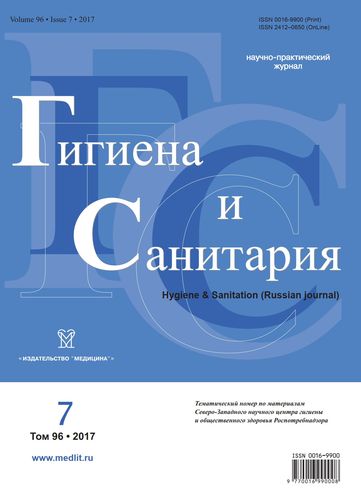On the issue of the use of health risk assessment techniques for hygienic characteristics of water supply systems
- Authors: Fridman K.B.1, Novikova Y.A.1, Belkin A.S.2
-
Affiliations:
- North-West Public Health Research Center
- I.I. Mechnikov North-Western State Medical University
- Issue: Vol 96, No 7 (2017)
- Pages: 686-689
- Section: ASSESSMENT OF HEALTH FACTOR RISKS
- Published: 15.07.2017
- URL: https://ruspoj.com/0016-9900/article/view/638449
- DOI: https://doi.org/10.47470/0016-9900-2017-96-7-686-689
- ID: 638449
Cite item
Full Text
Abstract
The study was aimed to assess the dynamics of risk indices for population health at main stages of surface source water treatment for centralized domestic water supply of the Leningrad region communities. Practical application issues of calculation procedure for the integrated assessment of drinking water from centralized water supply by chemical safety indices, as exemplified by Vsevolozhsk communities (Leningrad region) water supply from the Lake Ladoga and the Neva River as water sources, are discussed. Results of quality monitoring of water from centralized domestic supply system at the stage of water intake, at the output of water treatment, and in the distributing system, accomplished by Russian Federal Service for Surveillance on Consumer Rights Protection and Human Wellbeing administration and Center of hygiene and epidemiology in the Leningrad region were used as study materials. The following study techniques were used: descriptive statistics, comparative analysis, risk assessment, generalization. Microsoft Excel program was used for analysis and statistical treatment. Integral water quality index appears to be quite an informative integrated index of the efficacy of the water treatment, however, the same index value can be derived by various combinations of risk values of reflex-olfactory, non-carcinogenic and carcinogenic effects. Therefore, during the calculations, a “risk index of the effects of chronic exposure” was introduced with a view to distinguishing them from effects caused by the adverse organoleptic properties of water (reflex-olfactory effects). For the population these properties are the main reason for refusal from the use drinking water, and at the same time they are physiological, lying outside the pathology. The risk of effects of chronic exposure, carcinogenic and non-carcinogenic, expresses the probability of the development of pathology in time, but not the likelihood of an immediate refusal to use drinking water due to its unsatisfactory organoleptic qualities.
About the authors
K. B. Fridman
North-West Public Health Research Center
Author for correspondence.
Email: noemail@neicon.ru
ORCID iD: 0000-0001-7189-0141
Russian Federation
Yuliia A. Novikova
North-West Public Health Research Center
Email: novikova@s-znc.ru
ORCID iD: 0000-0003-4752-2036
Head of the department of analysis, assessment and forecasting of the North-West Public Health Research Center, Saint-Petersburg, 191036, Russian Federation.
e-mail: novikova@s-znc.ru
Russian FederationA. S. Belkin
I.I. Mechnikov North-Western State Medical University
Email: noemail@neicon.ru
ORCID iD: 0000-0001-9258-3888
Russian Federation
References
- Krasovskiy G.N., Rakhmanin Yu.A., Egorova N.A. Hygienic grounding of optimization of integral estimation of drinking water by water quality index. Gigiena i sanitariya. 2015; (5): 5–10. (in Russian)
- Documents for the state report «On the status of sanitary-epidemiological well-being of population in Leningrad region in 2015». Available at: http://47.rospotrebnadzor.ru/rss_all/-/asset_publisher/Kq6J/content/id/1479678 (in Russian)
- Fridman K.B. Outlook for drinking water supply of megapolises. In: Fridman K.B., Kryukova T.V., Belkin A.S., Bashketova N.S., Romantsova V.L. All-Russian Conference with international participants «Preventive Medicine-2014». Collection of Abstracts [Vserossiyskaya konferentsiya s mezhdunarodnym uchastiem «Profilakticheskaya meditsina-2014»: Sbornik tezisov]. St. Petersburg; 2014: 157–60. (in Russian)
- Gorbanev S.A., Vorob’eva L.V., Lomtev A.Yu., Maymulov V.G. Problems of Hygienic Safety of Domestic Water Supply and Population Health of Leningrad Region: Monograph [Problemy gigienicheskoy bezopasnosti khozyaystvenno-pit’evogo vodosnabzheniya i zdorov’ya naseleniya Leningradskoy oblasti: Monografiya]. St. Petersburg; 2006. (in Russian)
- Gorbanev S.A., Novikova Yu.A., Alent’eva O.S. On the experience of using results of social-hygienic monitoring of drinking water quality for identifying persons culpable of environment pollution. In: Current Problems of Safety and Health Risk Assessment of Population Exposed to Environmental Factors: Proceedings of All-Russian Conference [Aktual’nye problemy bezopasnosti i otsenki riska zdorov’yu naseleniya pri vozdeystvii faktorov sredy obitaniya: Materialy vserossiyskoy konferentsii]. Perm’; 2015: 137–41. (in Russian)
- Mel’tser A.V., Erastova N.V., Mozzhukhina N.A., Mel’tser A.A. On the problem of drinking water quality regulation in Russian Federation and in certain former Soviet republics. Profilakticheskaya i klinicheskaya meditsina. 2015; (1). Available at: http://profclinmed.szgmu.ru/PIK_1-2015_END.pdf (in Russian)
- Mel’tser A.V., Erastova N.V., Kiselev A.V. Experience of implementation of integral estimation method of drinking water by chemical safety indices in St.-Petersburg. Gigiena i sanitariya. 2013; 94(5): 31–4. (in Russian)
- Koverga A.V., Strikhar Yu.V. Drinking water quality: barrier role of water treatment plants. Vodosnabzhenie i sanitarnaya tekhnika. 2007; (9): 16–21. (in Russian)
- Tul’skaya E.A. Comparative safety of water disinfectants. Zdorov’e naseleniya i sreda obitaniya. 2013; (11): 22–4. (in Russian)
- Chernichenko I.A., Serdyuk A.M., Litovchenko O.N., Balenko N.V. Carcinogenic hazard of chloroform and other by-products of drinking water chlorination. Gigiena i sanitariya. 2009; 88(3): 28–33. (in Russian)
Supplementary files









